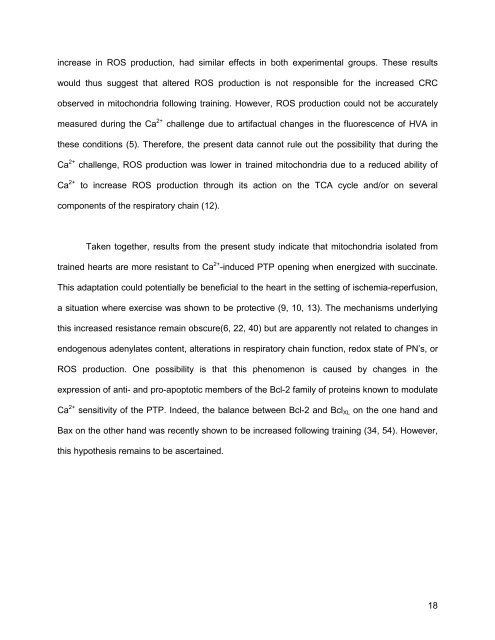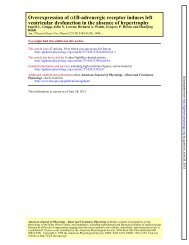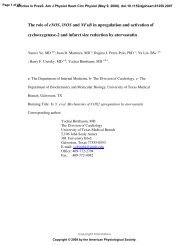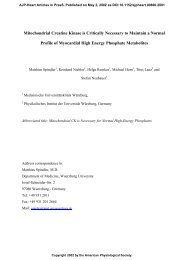increase in ROS production, had similar effects in both experimental groups. These results would thus suggest that altered ROS production is not responsible for the increased CRC observed in mitochondria following training. However, ROS production could not be accurately measured during the Ca 2+ challenge due to artifactual changes in the fluorescence of HVA in these conditions (5). Therefore, the present data cannot rule out the possibility that during the Ca 2+ challenge, ROS production was lower in trained mitochondria due to a reduced ability of Ca 2+ to increase ROS production through its action on the TCA cycle and/or on several components of the respiratory chain (12). Taken together, results from the present study indicate that mitochondria isolated from trained hearts are more resistant to Ca 2+ -induced PTP opening when energized with succinate. This adaptation could potentially be beneficial to the heart in the setting of ischemia-reperfusion, a situation where exercise was shown to be protective (9, 10, 13). The mechanisms underlying this increased resistance remain obscure(6, 22, 40) but are apparently not related to changes in endogenous adenylates content, alterations in respiratory chain function, redox state of PN’s, or ROS production. One possibility is that this phenomenon is caused by changes in the expression of anti- and pro-apoptotic members of the Bcl-2 family of proteins known to modulate Ca 2+ sensitivity of the PTP. Indeed, the balance between Bcl-2 and BclXL on the one hand and Bax on the other hand was recently shown to be increased following training (34, 54). However, this hypothesis remains to be ascertained. 18
REFERENCES 1. Argaud L, Gateau-Roesch O, Chalabreysse L, Gomez L, Loufouat J, Thivolet-Bejui F, Robert D, and Ovize M. Preconditioning delays Ca2+-induced mitochondrial permeability transition. Cardiovasc Res 61: 115-122, 2004. 2. Arieli Y, Gursahani H, Eaton MM, Hernandez LA, and Schaefer S. Gender modulation of Ca(2+) uptake in cardiac mitochondria. J Mol Cell Cardiol 37: 507-513, 2004. 3. Baines CP, Kaiser RA, Purcell NH, Blair NS, Osinska H, Hambleton MA, Brunskill EW, Sayen MR, Gottlieb RA, Dorn GW, Robbins J, and Molkentin JD. Loss of cyclophilin D reveals a critical role for mitochondrial permeability transition in cell death. Nature 434: 658, 2005. 4. Basso E, Fante L, Fowlkes J, Petronilli V, Forte MA, and Bernardi P. Properties of the Permeability Transition Pore in Mitochondria Devoid of Cyclophilin D. J Biol Chem 280: 18558-18561, 2005. 5. Batandier C, Leverve X, and Fontaine E. Opening of the mitochondrial permeability transition pore induces reactive oxygen species production at the level of the respiratory chain complex I. J Biol Chem 279: 17197-17204, 2004. 6. Bernardi P. Mitochondrial transport of cations: channels, exchangers, and permeability transition. Physiol Rev 79: 1127-1155., 1999. 7. Bernardi P. Modulation of the mitochondrial cyclosporin A-sensitive permeability transition pore by the proton electrochemical gradient. Evidence that the pore can be opened by membrane depolarization. J Biol Chem 267: 8834-8839, 1992. 8. Bernardi P, Vassanelli S, Veronese P, Colonna R, Szabo I, and Zoratti M. Modulation of the mitochondrial permeability transition pore. Effect of protons and divalent cations. J Biol Chem 267: 2934-2939, 1992. 9. Bowles DK, Farrar RP, and Starnes JW. Exercise training improves cardiac function after ischemia in the isolated, working rat heart. Am J Physiol 263: H804-809., 1992. 10. Bowles DK and Starnes JW. Exercise training improves metabolic response after ischemia in isolated working rat heart. J Appl Physiol 76: 1608-1614., 1994. 11. Brenner C, Cadiou H, Vieira HL, Zamzami N, Marzo I, Xie Z, Leber B, Andrews D, Duclohier H, Reed JC, and Kroemer G. Bcl-2 and Bax regulate the channel activity of the mitochondrial adenine nucleotide translocator. Oncogene 19: 329-336., 2000. 12. Brookes PS, Yoon Y, Robotham JL, Anders MW, and Sheu SS. Calcium, ATP, and ROS: a mitochondrial love-hate triangle. Am J Physiol Cell Physiol 287: C817-833, 2004. 13. Brunner M, Moeslinger T, and Spieckermann PG. Regulation of cyclosporin A sensitive mitochondrial permeability transition by the redox state of pyridine nucleotides. Comp Biochem Physiol B Biochem Mol Biol 128: 31-41, 2001. 14. <strong>Burelle</strong> Y, Wambolt RB, Grist M, Parsons HL, Chow JC, Antler C, Bonen A, Keller A, Dunaway GA, Popov KM, Hochachka PW, and Allard MF. Regular exercise is associated with a protective metabolic phenotype in the rat heart. Am J Physiol Heart Circ Physiol 287: H1055- 1063, 2004. 15. Clarke SJ, McStay GP, and Halestrap AP. Sanglifehrin A acts as a potent inhibitor of the mitochondrial permeability transition and reperfusion injury of the heart by binding to cyclophilin-D at a different site from cyclosporin A. J Biol Chem 277: 34793-34799., 2002. 16. Crompton M. The mitochondrial permeability transition pore and its role in cell death. Biochem J 341: 233-249., 1999. 17. Crompton M, Ellinger H, and Costi A. Inhibition by cyclosporin A of a Ca2+-dependent pore in heart mitochondria activated by inorganic phosphate and oxidative stress. Biochem J 255: 357-360., 1988. 18. Di Lisa F and Bernardi P. Mitochondrial function as a determinant of recovery or death in cell response to injury. Mol Cell Biochem 184: 379-391., 1998. 19






